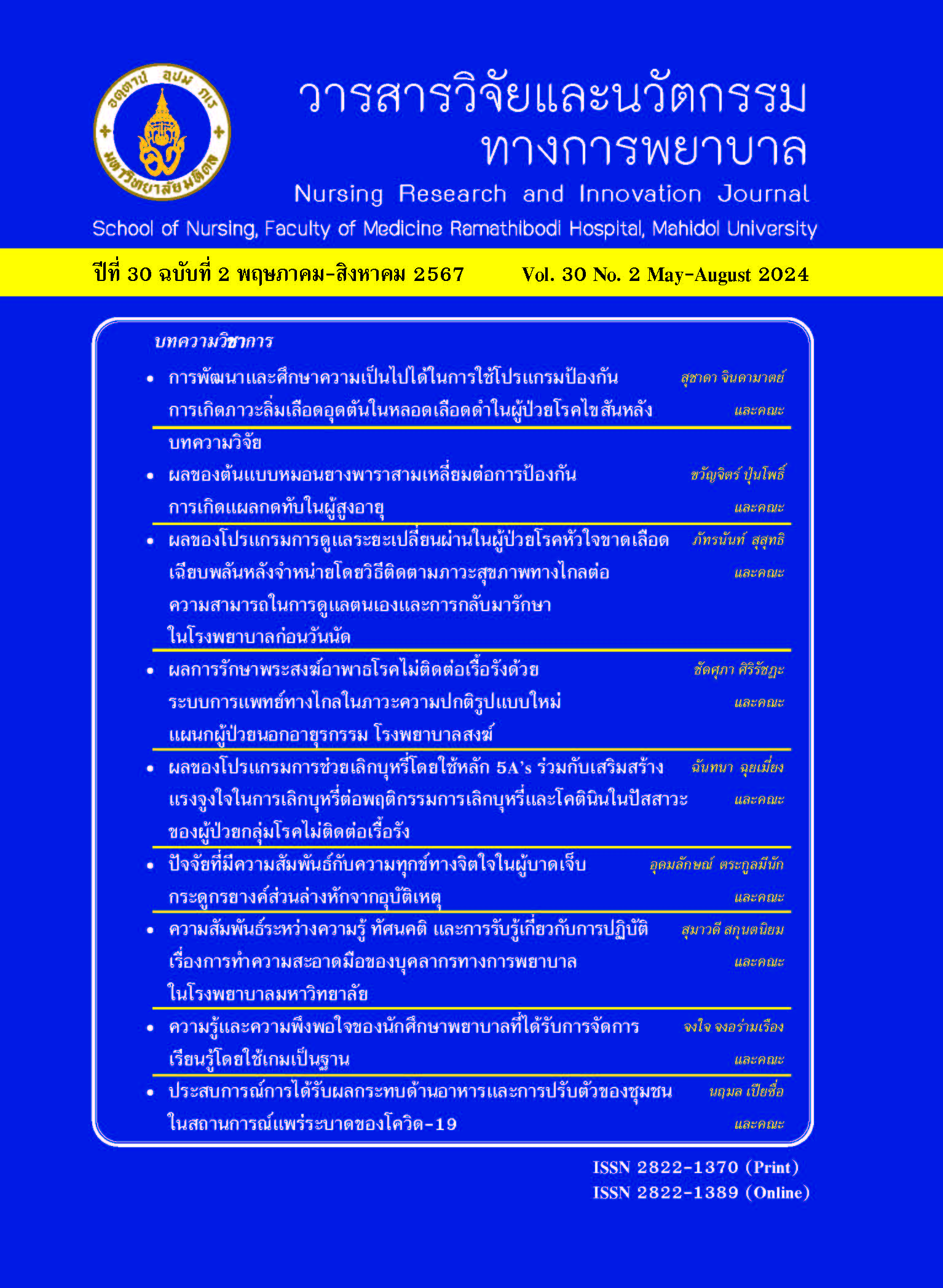Development and Feasibility Study of a Prevention Program of Venous Thromboembolism in Patients with Spinal Cord Disorders
Main Article Content
Abstract
Venous thromboembolism is a common complication in patients with spinal cord disorders, resulting in the need for long-term care, an increased length of hospital stays, a higher cost of care, and an increased risk of death. Most patients with spinal cord disorders receive delayed investigation and treatment due to variant risk assessment and management. Based on a literature review, current evidence suggests employing pharmaceutical and non-pharmaceutical methods for preventing venous thromboembolism.Even though pharmaceutical prevention, especially low-molecular-weight heparin, is effective, the critical side effects, including the risk of bleeding, need to be considered.Thus, the researchers developed a program focusing on non-pharmaceutical strategies to prevent venous thromboembolism in patients with spinal cord disorders based on Soukup’s conceptual framework. This developed program was named “5E,” including 1) education, 2) elevation, 3) exercise, 4) enough fluid, and 5) early application of intermittent pneumatic compression. The content validity index evaluated by five experts was 1.00. After modification, the pilot program was tried out in two patients diagnosed with spinal cord disorders, and the results showed that the 5E program was feasible to implement in a clinical setting. However, the effect of this prevention program on venous thromboembolism must be studied further.
Keywords: Prevention program, Spinal cord disorder, Venous thromboembolism
Article Details

This work is licensed under a Creative Commons Attribution-NonCommercial-NoDerivatives 4.0 International License.
บทความ ข้อมูล เนื้อหา รูปภาพ ฯลฯ ที่ได้รับการตีพิมพ์ในรามาธิบดีพยาบาลสาร ถือเป็นลิขสิทธิ์ของวารสาร หากบุคคลหรือหน่วยงานใดต้องการนำทั้งหมดหรือส่วนหนึ่งส่วนใดไปเผยแพร่หรือเพื่อกระทำการใด ใด จะต้องได้รับอนุญาตเป็นลายลักษณ์อักษรจากรามาธิบดีพยาบาลสารก่อนเท่านั้น
References
Pattanakuhar S, Kammuang-lue P, Tongprasert S,Kovindha A, Tantiworawit A. Prevention for Venous Thromboembolism in Spinal Cord Injury Patients. Journal of Thai Rehabilitation Medicine. 2018;28(1):24-31.(in Thai)
Shang Z, Wanyan P, Zhang B, Wang M, Wang X.Incidence and risk factors of deep vein thrombosis in patients with spinal cord injury: a systematic review with meta-analysis. Front Cardiovasc Med. 2023;10(May):1–12
Siangyai S. Color Doppler ultrasound determination in deep vein thrombosis patients. The Thai Journal of Radiological Technology. 2018(43):6-12. (in Thai)
Weidner N, Müller OJ, Hach-Wunderle V, Schwerdtfeger K, Krauspe R, Pauschert R, et al. Prevention of thromboembolism in spinal cord injury-S1 guideline.Neurol Res Pract.2020;2,43(2020). https://doi.org/10.1186/s42466-020-00089-7
Fernandez MM, Hogue S, Preblick R, Kwong WJ. Review of the cost of venous thromboembolism. Clin Outcomes Research. 2015;7:451–62.
Wilson K, Devito D, Zavotsky KE, Rusay M, Allen M,Huang S. Keep it moving and remember to P.A.C.(Pharmacology, ambulation, and compression) for venous thromboembolism prevention. Orthop Nurs. 2018;37(6):339–45. https://doi.org/10.1097/NOR.000000
Lutsey PL, Zakai NA. Epidemiology and prevention of venous thromboembolism. Nat Rev Cardiol. 2023;20:248–62. https://doi.org/10.1038/s41569-022-00787-6
Lv B, Wang H, Li W, Han G, Liu X, Zhang C, et al.Admission prevalence and risk factors of deep vein thrombosis in patients with spinal cord injury complicated with cervical fractures. Clin Appl Thromb. 2022;28.doi:10.1177/10760296221108969.
Eckert MJ, Martin MJ. Trauma: spinal cord injury. Surg Clin North Am. 2017;97(5):1031–45.
Wei B, Zhou H, Liu G, Zheng Y, Zhang Y, Hao C, et al.Risk factors for venous thromboembolism in patients with spinal cord injury: a systematic review and meta-analysis.J Spinal Cord Med. 2023;46(2):181–93.
Morotti A, Goldstein JN. Anticoagulant-associated intracerebral hemorrhage. Brain Hemorrhages [Internet].2020;1(1):89–94.
Gomes Et, Assuncao MCT, Lins EM, Purchel VAA.Nursing in mechanical prevention of venous thromboembolism in surgical patients: Rev Esc Enferm USP. 2021;55:2-6.
Plueangklang A, Chaiviboontham S, Sa-ngasoongsong P, Jaovisidha S, Buangam C. Effect of the foot and ankle exercise on blood flow velocity of the common femoral Vein in patients with hip fracture. Ramathibodi Nursing Journal. 2021;27(1):92-107. (in Thai)
Promlek K. The development and evaluation of clinically III trauma patients [thesis]. Songkla: Prince of Songkla University; 2010. (in Thai)
Chuenjit K. The effect of leg exercise combined with reflexology on femoral venous blood flow velocity in post abdominal surgery patients [thesis]. Bangkok: Chulalongkorn University; 2014. (in Thai)
Nicholson M, Chan N, Bhagirath V, Ginsberg J. Prevention of venous thromboembolism in 2020 and beyond. J Clin Med. 2020;9(8):2467. doi: 10.3390/jcm9082467.
Xu Y, Siegal DM. Anticoagulant-associated gastrointestinal bleeding: Framework for decisions about whether, when and how to resume anticoagulants. J Thromb Haemost [Internet]. 2021;19(10):2383–93.
Soukup SM. The center for advanced nursing practice evidence-based practice model: promoting the scholarship of practice. Nurs Clin North Am. 2000;35(2):301-9.
Stone J, Hangge P, Albadawi H, Wallace A, Shamoun F,Knuttien MG, et al. Deep vein thrombosis: pathogenesis,diagnosis, and medical management. Vol. 7, Cardiovascular Diagnosis and Therapy; 2017. p. S276–84.
Kummatid A, Markrat M. Using the systematic review to provide a complete summary on a research question in evidence-based practice: a 3-step method. South Coll Netw J Nurs Public Heal. 2016;3(3):246–59.
Aufwerber S, Praxitelous P, Edman G, Silbernagel KG,Ackermann PW. Increased risk of deep venous thrombosis in patients with poor ankle dorsiflexion after lower limb immobilization. OTA Int. 2019;2(2):e038. doi:10.1097/OI9.0000000000000038.eCollection 2019 Jun.
Shang Z, Wanyan P, Zhang B, Wang M, Wang X.Incidence and risk factors of deep vein thrombosis in patients with spinal cord injury: a systematic review with meta-analysis. Front Cardiovasc Med. 2023;10:1–12.
Shbeer A. Extensive lower limb deep vein thrombosis provoked by gastroenteritis-induced dehydration: a case report for unusual precipitating factor. Int Med Case Rep J. 2022;15:713–8.
Collin R, Maclellan L, Gibbs H, MacLellan D, Fletcher J. Venous thromboembolism prophylaxis: the role of the nurse in changing practice and saving lives. Aust J Adv Nurs. 2013;27(3):83-9.
Russell LA, Sigmund AE, Szymonifka J, Jawetz ST, GrondSE, Dey SA, et al. Does my patient have a pulmonary embolism? The wells vs. PISA 2 rule in orthopedic patients. J Thromb Thrombolysis [Internet]. 2018;45(3):417–22.
Lin P, Wiley JA, Tian L, Li W, Yang Q, Yang H, et al.Low awareness of venous thromboembolism among neurosurgical hospitalized patients: a cross-sectional study. Thrombosis Journal. 2023;21(1):1–15.
Russell LA, Sigmund AE, Szymonifka J, Jawetz ST, Grond SE, Dey SA, et al. Does my patient have a pulmonary embolism? The wells vs. PISA 2 rule in orthopedic patients. J Thromb Thrombolysis [Internet]. 2018;45 (3):417–22.


